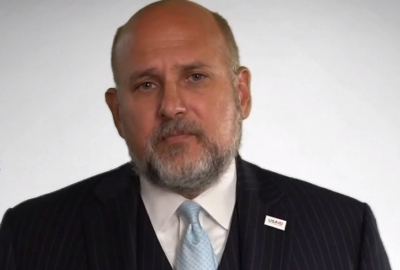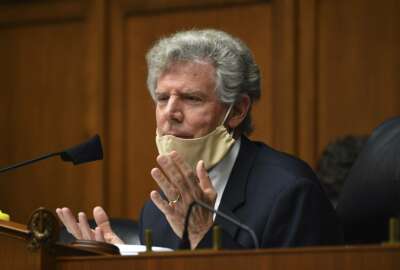
USAID, FCC team up on improving 5G policies
The U.S. Agency for International Development and the FCC might seem like strange bedfellows, but they've got an interest in 5G.
Best listening experience is on Chrome, Firefox or Safari. Subscribe to Federal Drive’s daily audio interviews on Apple Podcasts or PodcastOne.
The U.S. Agency for International Development and the FCC might seem like strange bedfellows, but they’ve got an interest in 5G, a highly touted next generation of broadband wireless communications. Now they’ve signed a Memorandum of Understanding aimed at improving adherence to several policies on 5G in emerging markets. For what this is all about, USAID Deputy Administrator Bonnie Glick joined Federal Drive with Tom Temin.
Interview transcript:
Tom Temin: Ms. Glick, good to have you on.
Bonnie Glick: Tom, it’s great to be on. Thanks for having me today.
Tom Temin: A memorandum of understanding between USAID and the FCC – tell us what it covers.
Bonnie Glick: Sure. As you noted, rightly having USAID – the U.S. Agency for International Development – which really has a broad international focus on developing or emerging market countries does seem like a strange interlocutor for the Federal Communications Commission. But one of the things that I’ve talked with [FCC] Chairman Ajit Pai and Commissioner Brendan Carr about extensively, is the importance and significance of 5G, the fifth generation broadband technology as an important issue for developing countries. And people kind of scratch their heads and wonder, well, you know, Europe and Japan and Korea is what we think about for 5G. We don’t really think about emerging market countries. But at USAID, our focus is working with countries who are, as we believe, continuing along their development journeys towards self reliance. And it’s our firm belief that in order to be self reliant, a country has to be a full participant in the global economy. If we’ve seen nothing else from COVID-19, we’ve seen how important connectivity is. So you and I are not meeting live in a studio. We’re doing this remotely together. And that’s the way everything is being erected around the world right now.
Tom Temin: So getting to the memorandum, what is FCC trying to accomplish here? And what is the USAID trying to do?
Bonnie Glick: It’s a good question, how we align. FCC is going to help us at USAID with things like rolling out training in developing countries, helping us work with ministries of information, communications and telecommunications, to have them have the right tools available to them to understand when they’re ready to make 5G decisions, what those decisions should look like. And we focus together, things like the clean network, having countries make decisions that are based on what is technology that will best serve your citizens. And that includes from a US government perspective, technology that doesn’t include – Chinese technologies like Huawei, ZTE, and other – what we refer to in the government [as] covered technologies from the People’s Republic of China. So FCC, working very hard and very diligently at rolling out broadband connectivity in the United States, including to rural communities, has a great handle on what are the ways to advise decision makers on what the proper technologies are for broadband connectivity. And they’re tremendously helpful to us in helping develop those decisions in emerging market countries.
Tom Temin: And I guess you have an immediate issue there in some of these countries where say, education has been interrupted. And they don’t have the broadband capabilities that we do here to have tele-education. So there’s some real pressing issues for those countries. And this is not a long term problem necessarily.
Bonnie Glick: Right, Tom, it’s a critical issue, not just in the emerging market countries themselves, but also when you think about it in the countries where USAID works, we work with a lot of populations of internally displaced people who have been displaced by conflict, or refugees. And these are populations that also frequently are living away from where they should be. At the latest count, we have something like 70 million people around the world who are not where they should be. They’re not in their homes. And so the ability through COVID to be able to educate children in particular and provide training to young workers is that much more important to be able to provide digitally over the internet. And so USAID works with governments, works with service providers to help bring that connectivity to populations that we in the United States don’t always think about. The populations that still have to educate their children, still have to transact business and still have to maintain their livelihoods.
Tom Temin: We’re speaking with Bonnie Glick, she’s Deputy Administrator for the U.S. Agency for International Development. And what tools does USAID have to encourage countries to avoid the Chinese gear, for example, and buy from some of the companies that we can, pretty much are assured are trustworthy?
Bonnie Glick: USAID is leading the US government efforts in 5G in the developing world. So we partner with other parts of the US government: The State Department, the Commerce Department, Export Import Bank, the [U.S. International] Development Finance Corporation in order – and FCC of course – in order to advise countries on how they get to the next stage, the next generation of broadband connectivity. USAID by and large, offers what we refer to as technical assistance and capacity building, which fundamentally comes down to financing tools, as well as training, education, counseling, guidance, consulting services, and then other US government agencies like the Development Finance Corporation and EXIM come in with larger scale financing capabilities. But it’s all part of an overall US government response that we’ve raised the profile on, because we believe so strongly that 5G is important for emerging markets.
Tom Temin: That financing piece is particularly important because the Chinese will say “We’ll loan you the money, and then we own you,” basically.
Bonnie Glick: Yeah, what we’ve seen around the world and a couple of cases would be things like, not necessarily related to telecommunications, but the most significant case of bait and switch I’ll call it is the Chinese government coming into the island country of Sri Lanka, in the Indian Ocean and offering to help the Sri Lankans build a port with concessionary loans, and the concessionary loans were at a level that ultimately the government of Sri Lanka could not repay. Because the promise of the PRC was that there would be a tremendous increase in revenues coming into that port, which never materialized. And so the fine print of the contract that the government of Sri Lanka signed with the PRC was that they would give up sovereignty and control over the port, handing it over to the People’s Republic of China for management and running for 99 years. And so they lost control not only of this port – new age port – for an island country, critically important for revenues, but also they lost face to the People’s Republic of China in terms of having made this bad deal. And what we together with other aligned donors are doing is working with countries to help assure that they don’t make similar mistakes.
Tom Temin: Sure, it’s like borrowing from the Gambinos. And getting back to getting back to the 5G idea, are some nations going to go directly to 5G and kind of skip 3G and 4G LTE?
Bonnie Glick: That’s a great tech question. And one of the things that we talk about a lot in developing countries is very much like emerging markets, leapfrogged landlines and went directly to mobile phones. We do believe that there are technologies that are coming online that will provide broadband connectivity that won’t be dependent on large scale infrastructure build outs like 5G would require, like 4G has required. And so there are new technologies that are coming out of additional countries to include the United States and Japan, called open radio access network technologies. And this would provide countries with a much less expensive software, not hardware-based solution for broadband connectivity. And so we do believe that open RAN as it’s called, open radio access network, that are these software-based solutions that are starting to be rolled out in pilots around the world, including in developed countries like the U.S. and Japan, may very well prove to be that leapfrog technology that could be a game changer in emerging markets.
Tom Temin: And the final question, if you can answer it, whatever happened to the $100 laptop?
Bonnie Glick: Ah, you know, that is a good question. I believe that it was a program probably about 10 years or so ago, called One Laptop Per Child. My husband and I actually participated in it where we were providing at a very low cost, I guess it was about $100, laptops for children in developing countries. I’m not sure where that has gone. Those were – those predated actually the Chromebooks that we see now or the tablets that we see now. So my sense is in the countries that I’ve visited during the course of my time at USAID and it’s been several dozen countries, I have yet to see one of those bright green colored laptops in children’s classrooms. So my sense is they’ve probably graduated from those towards smart tablets and newer technologies.
Tom Temin: Bonnie Glick is deputy administrator of the U.S. Agency for International Development. Thanks so much for joining me.
Bonnie Glick: Tom, thanks so much for having me today.
Tom Temin: We’ll post this interview together with a link to the strategy at FederalNewsNetwork.com/FederalDrive. Hear the Federal Drive on demand. Subscribe at Podcastone or wherever you get your podcasts.
Copyright © 2024 Federal News Network. All rights reserved. This website is not intended for users located within the European Economic Area.
Tom Temin is host of the Federal Drive and has been providing insight on federal technology and management issues for more than 30 years.
Follow @tteminWFED
Related Stories

USAID digital strategy opens door to workforce proficiency in ‘cutting-edge technologies’




